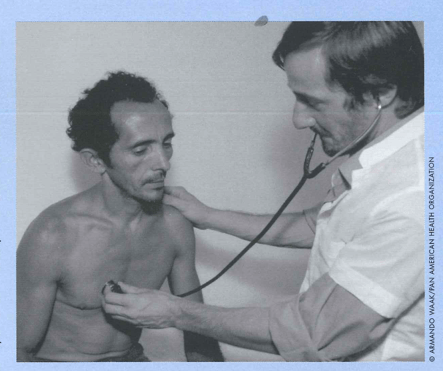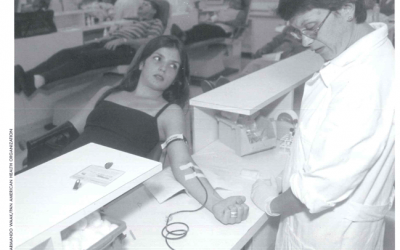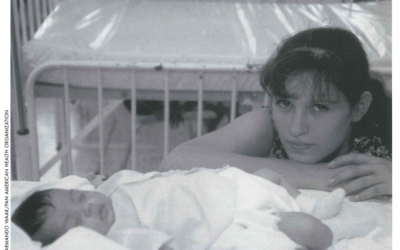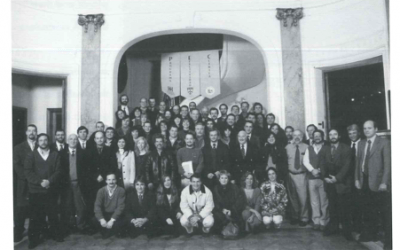Baluchistan to Brazil
Lessons in Listening to the Community

Listening with a stethoscope can be easier than listening to a community.
The two-year-old Pakistani tot was close to death because of malnutrition and diarrhea. His parents, nomads from the westernmost part of the country, had made the arduous 180-mile trip to seek medical care in Quetta, the provincial capital. Almost certainly, his life would have been saved if his diarrhea had been treated at home with oral rehydration. After a well-intentioned trip he was now almost certain to die within a very few hours. I couldn’t stop weeping as I stood among a team of colleagues visiting the pediatric ward of a local hospital.
It was 1992. I had graduated from a doctoral program at the Harvard School of Public Health (HSPH), where I focused on determinants of child malnutrition in Bogotá, Colombia. I’d been lucky enough to obtain this consultancy in Pakistan. My total inability to help the nomad child was my first experience in seeing the truly critical need to consciously link epidemiological and clinical research to action. It made me realize the need for programs and policies developed by listening to voices at different levels in the social context of children.
At that moment, my approach to the consultancy to suggest strategies to train community health workers in nutrition education?shifted dramatically. Rather than crafting my recommendations to fit the framework of U.S. – based agencies paying for my trip, I knew I must respond to the voices from the community: the caregivers, community health workers, Pakistani pediatricians and seasoned government health officials.
Halfway around the world, Ana Cristina de Souza had begun working in the early 1990?s in community clinics and with grassroots women’s groups in Brazil, an experience that would ultimately lead to her pursuit of a MPH and PhD degree at HSPH. In 1994, she began working with Alberto Ascherio and myself to develop and conduct her doctoral research, in collaboration with colleagues at Federal University of Fortaleza, and UNICEF.
“I believe that it is only when communities and programs are truly engaged in the inquiry that researchers can make a substantial contribution to the improvement of health and social programs designed to better the lives of individuals and their communities. explains de Souza. ” With the funding of DRCLAS, the two research projects we conducted in Ceará, NE Brazil are example of the application of a partnership research model as a strategy to facilitate the development of individuals and communities consistent with research goals.”
De Souza’s doctoral research evaluated the P.A.C.S. program, a state government based program of paid community health workers implemented on a municipal basis was launched by the State Secretariat of Health with the technical support of UNICEF in 1987 (see DRCLAS NEWS, Spring 1998).
Peterson and de Souza received DRCLAS funding in 1999 to return to Ceará to conduct qualitative research assessing factors that may have hindered or facilitated the utilization of evaluation results for improving programs and designing policies to address the nutritional status of children in Ceará. “A growing body of research has demonstrated that communication strategies used during and after the conduct of community-based research increase likelihood the research will result in actions.” In the past two year through her work as a post-doctoral research fellow in program evaluation with the Harvard Children’s Initiative, De Souza worked with Carol Weiss of the Graduate School of Education to develop a framework that examines the main factors associated with utilization of evaluation results to improve programs and design policies (“What Happens to Evaluation Results?” Harvard Children’s Initiative, 1999).
For the evaluation of the PACS program we used a partnership model, bringing together key influential people to negotiate the design and implementation of the evaluation. This group included the UNICEF Representative in Ceará, health officials and program staff at the State Secretariat of Health and Municipal Secretariats of Health, and researchers from the School of Public Health in Ceará. Dr. Anastacio de Queiroz Sousa, Ceará State Secretary of Health, who recently visited Cambridge and Boston, as part of the DRCLAS Brazil Public Health initiative, noted, “the collaboration between academic institutions like Harvard and us (i.e. health officials and program staff at State Secretariat of Health) strengthens the work of our group.”
The preliminary results of our research confirmed the importance of creating and sustaining a dialogue between research institutions and programs. The results of the in-depth interviews with program officials at different levels of decision-making process revealed how the information from the evaluation has been used by program officials to improve nutrition programs and design policy that address modifiable factors affecting the nutrition status of children and their communities.
The new field research examined the link between data and action to see whether growth-monitoring data used for program evaluation influence decisions and improves data quality and usefulness at the individual, program and ecological level.
Specifically, this qualitative field research looked at how Ceará State and municipal decision-makers, municipal program managers and CHW supervisors had used the P.A.C.S. GMP evaluation. Information will be used to recommend ways to maximize the usefulness of evaluation results at different administrative levels. We also will assess growth monitoring activities undertaken by CHWs that may influence quality of individual or aggregate data, including weighing and measuring techniques, plotting, recording of growth data. Study questions addressed:
-
Adequacy of communication and dissemination of research results.
-
Uses and interpretation of “new information” from the evaluation related to nutrition program and policy decisions in Ceará State.
-
Relevance of findings to the daily program operation and functioning at the municipality-level.
-
Factors influencing application of research and obstacles to understanding and implementing the changes at municipality and state levels.
-
How community health workers, decision-makers and agency officials understand 1) the concept of child growth, 2) information from measurement on child growth (individual and population levels), and 3) information from growth references.
-
Potential ways health officials and decision-makers could address the quality of data collection presented.
As a context for public health research, Pakistan is a completely different context from Brazil viewed from almost any perspective. But my qualitative research – based on listening to voices of people with different responsibilities in the care of children in Pakistan, and De Souza’s previous experience in working with rural communities in Brazil, was invaluable in deciding how to best listen to CHWs, supervisors, and decision-makers speak about whether and how our evaluation of GMP was useful.
Research methods included:
1) Interviews with key informants at State and Municipality decision-making levels: Actions taken and interpretations of P.A.C.S. evaluation data, relevance of the results for nutrition programs and policies in Ceará, and organizational and political obstacles to implementing recommendations.
2) In-depth interviews with P.A.C.S. Supervisors (i.e. municipal level): Uses and interpretation of evaluation data. Each supervisor is responsible for overseeing 10-15 CHWs.
3A) In-depth interviews with CHWs: Closed- and open-ended questions will be developed and used to assess CHWs’ knowledge, skills and practices regarding GMP, based on methods previously tested (Peterson et al., 1994).
3B) Direct observations of CHWs daily activities: Documentation of actual work routine, including recording, weighing, plotting, counseling, as well as on equipment used. A simple, standard data from will be developed and used to collect information across all locations based on our previous work.
The next project is entitled “Strategies for Implementing a New Growth Reference”, a collaborative effort of the Department of Maternal and Child Health and Department of Nutrition of Harvard School of Public Health, the Division of Nutritional Sciences of Cornell University, the State Secretariat of Health of Ceará, and the Department of Community Health of the Federal University of Ceará. This research proposes the use of qualitative methods to understand the factors that influencing effective and successful implementation and adoption of a new growth reference. The first set of factors relates to characteristics of the health systems, while the second relates to decision-makers, health workers and mothers understanding of growth and its measurement and interpretation for appropriate actions (WHO, 1995) appropriate to the user.
Field research to identify, define, and address issues related to initiation, implementation, and incorporation of the new international growth reference into various settings will be needed to inform governments and international agencies of methods for successful and improved implementation and use of this new technology worldwide. Research methods also will provide a prototype for ethnographic research on issues related to the implementation and adoption of the new WHO growth reference to be conducted in other countries.
This work in Ceará, informed by “listening” in Pakistan, will be amplified and further re-invented in upcoming year in the WHO project. The children of Ceará can never be an abstraction for either De Souza or myself. She has spent hours listening to the stories of mothers who have lost their children to malnutrition and disease. And I have never been able to erase from my mind the eyes of the two-year-old nomad boy who changed my vision of community health.
Fall 2000
Karen E. Peterson ScD, RD is an Associate Professor of Nutrition, Departments of Maternal and Child Health and of Nutrition and Director of Public Health Nutrition Practice, Harvard School of Public Health.
Ana Cristina Terra de Souza, DDS MPH, DrPH is a research fellow (Berkowitz Family Legal Sea Foods Fellowship)- Public Health Nutrition Practice De[artment of Nutrition and Maternal and Child Health, Harvard School of Public Health, and a Research Fellow in program evaluation with the Harvard Children’s Initiative. She is from Brazil.
Related Articles
Safe Blood for Transfusion
José Oscar Cotto López has donated 140 pints of blood since 1966. The 53-year old resident of San Salvador, El Salvador, does so because he believes it is an expression of love. “We must be…
Reproductive Health
On a hot, dusty day in the middle of a long drought, I attended a day-long assembly convened by the Ministry of Health’s Reproductive Health and Family Planning Program in Chulucanas, the…
Program in Clinical Effectiveness
As a family physician, I’ve always been interested in primary care and also in the broader perspective of health care systems focusing both on the individual patients and on populations…




